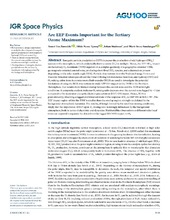Are EEP Events Important for the Tertiary Ozone Maximum?
Peer reviewed, Journal article
Published version

Åpne
Permanent lenke
https://hdl.handle.net/1956/23046Utgivelsesdato
2019Metadata
Vis full innførselSamlinger
Originalversjon
Journal of Geophysical Research (JGR): Space Physics. 2019, 124 (7), 5976-5994. https://doi.org/10.1029/2018ja026201Sammendrag
Energetic particle precipitation (EPP) increases the production of odd hydrogen (HOX ) species in the mesosphere, which catalytically destroy ozone (O3) in sunlight. Hence, the EPP‐HOX impact on the tertiary O3 maximum (TOM) depends on a complex geometry of a geographic‐oriented TOM, geomagnetic‐oriented auroral zone, producing short‐lived HOX species, and a destruction process depending on the solar zenith angle (SZA). Particle observations from the Medium Energy Proton and Electron Detectors telescopes aboard the Polar Orbiting Environmental Satellites, and hydroxyl (OH) and O3 mixing ratios from Aura microwave limb sounder (MLS) are used to investigate the potential limitations of using the MLS observations to study EPP‐OH impact on the TOM in the Northern Hemisphere. Our results show limited overlap between the auroral zone and the TOM at twilight conditions. A composite analysis indicates O3 mixing ratio decrease over the auroral zone lagged by ∼1 day compared to the maximum energetic electron precipitation (EEP)‐OH impact. Hence, MLS is predominantly observing a lagged and lower estimate of the response of O3 to EEP‐OH at SZA > 95°. The EEP impact region within the TOM is smaller than the overlap region, strongly modulated by the background atmospheric dynamics. The results, although limited by the satellites viewing conditions, imply that the importance of EEP upon O3 mixing ratio is strongly influenced by the background atmosphere, both in terms of chemistry and dynamics. Multisatellite observations at different solar local times are required to separate the direct from the lagged EEP‐OH impact on O3.
